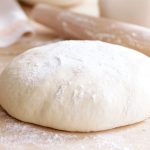 A mixture of flour and other ingredients stiff enough to knead or roll.
A mixture of flour and other ingredients stiff enough to knead or roll.
The Indo-European source of the word dough is also the ultimate source of many other words, including dairy and paradise. This ancient source, pronounced something like dheigh, meant to mould clay, but when it evolved into Germanic it came to mean to knead bread dough, a natural development considering that bakers and potters do essentially the same thing to different materials. This Germanic word then shifted meaning again as it came to refer not just to the action of kneading but to the actual material that is kneaded; it was this meaning that the word possessed when it emerged in Old English as dag, later respelt as dough. In some parts of northern England, the word dough came to be pronounced duff (like enough), a pronunciation that probably crept back into standard English in expressions such as, “Get off your duff,” the human duff being rather soft and doughy. The word dairy also derives from the same source as dough and duff: a thousand years ago, a woman whose job was to make dough for her community was called a daege, meaning kneader. Gradually daege lost this very narrow sense and came to denote any female servant; a little later, however, the word narrowed in meaning again as it came to refer to a woman whose job was to milk cows, make butter, and so on. Eventually, by the late twelfth century the shed where the daege did all her milk-work became known as the deierie, which acquired its current spelling, dairy, in the seventeenth century. The word paradise appears to have little in common with dough and dairy, but it does: the Persian ancestor of paradise—pairidaeza, meaning enclosed garden—was formed from pairi, meaning around, and diz, meaning to mould, the idea being that the walls of the garden are doner kebab dough moulded around it. The latter of these two Persian words—diz—derives from the same Indo-European source as dough and dairy, thus making paradise their distant cousin.
A composition of pulverized grain, specifically flour or a similar substance, combined with a form of liquid to create a cohesive and manageable substance.
Dough refers to a thick mixture consisting of uncooked flour and liquid, sometimes combined with other ingredients. This term is not exclusive to typical yeast dough, but is also applied to other mixtures such as pastry, cakes, biscuits, and cookies. When making pastry, the dough is considered “stiff” when only enough liquid is added to bind the ingredients together, such as with short-crust pastry. In cakemaking, a stiff dough contains enough liquid to make it too sticky to handle, yet still able to maintain its shape when dropped from a spoon, as seen with fruitcake dough. A “firm” dough is slightly softer but still relatively stiff, such as the mixture used for biscuits. Meanwhile, a “soft” dough contains a larger amount of liquid, making it just firm enough to handle, as with bread dough and other yeast-based mixtures.
